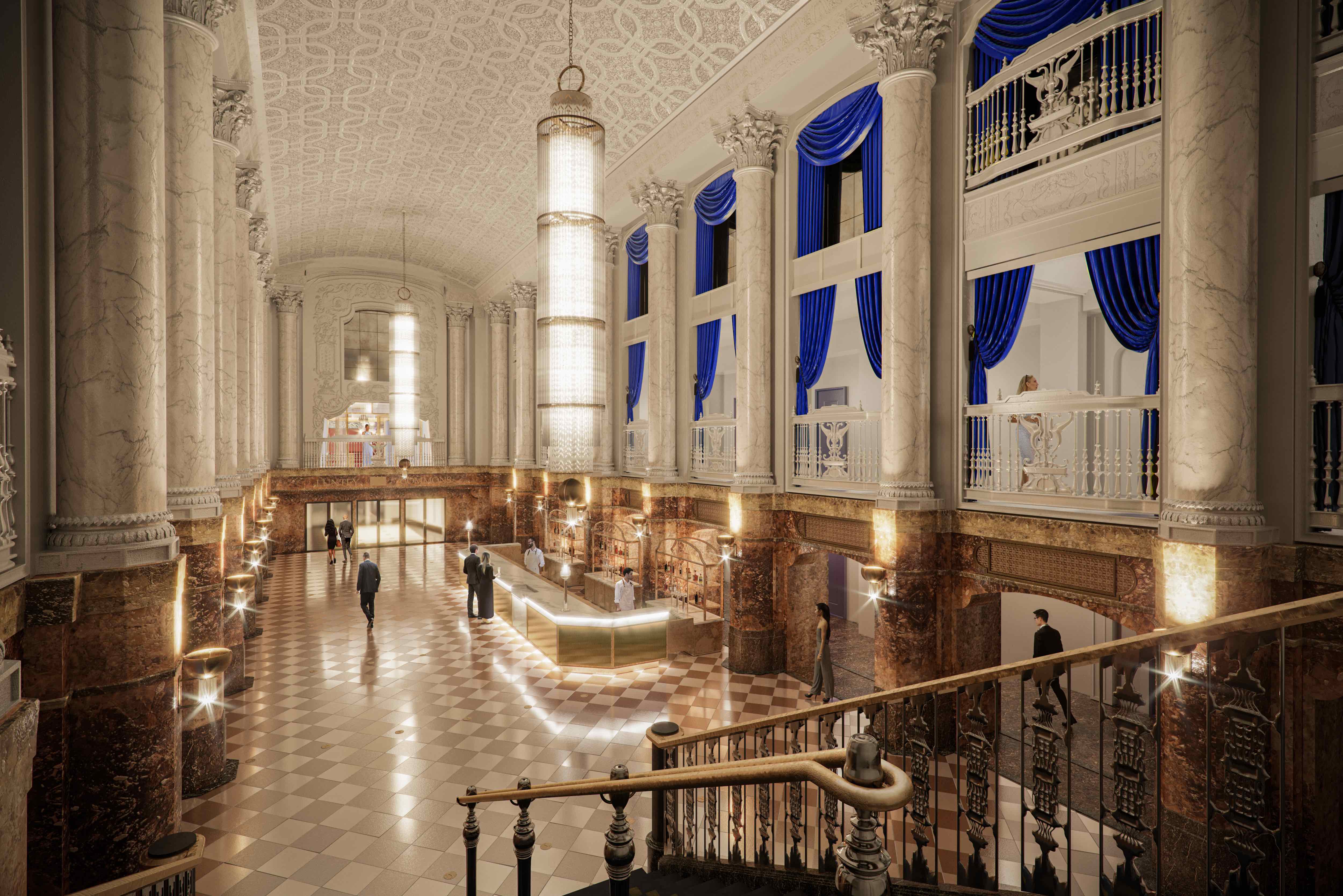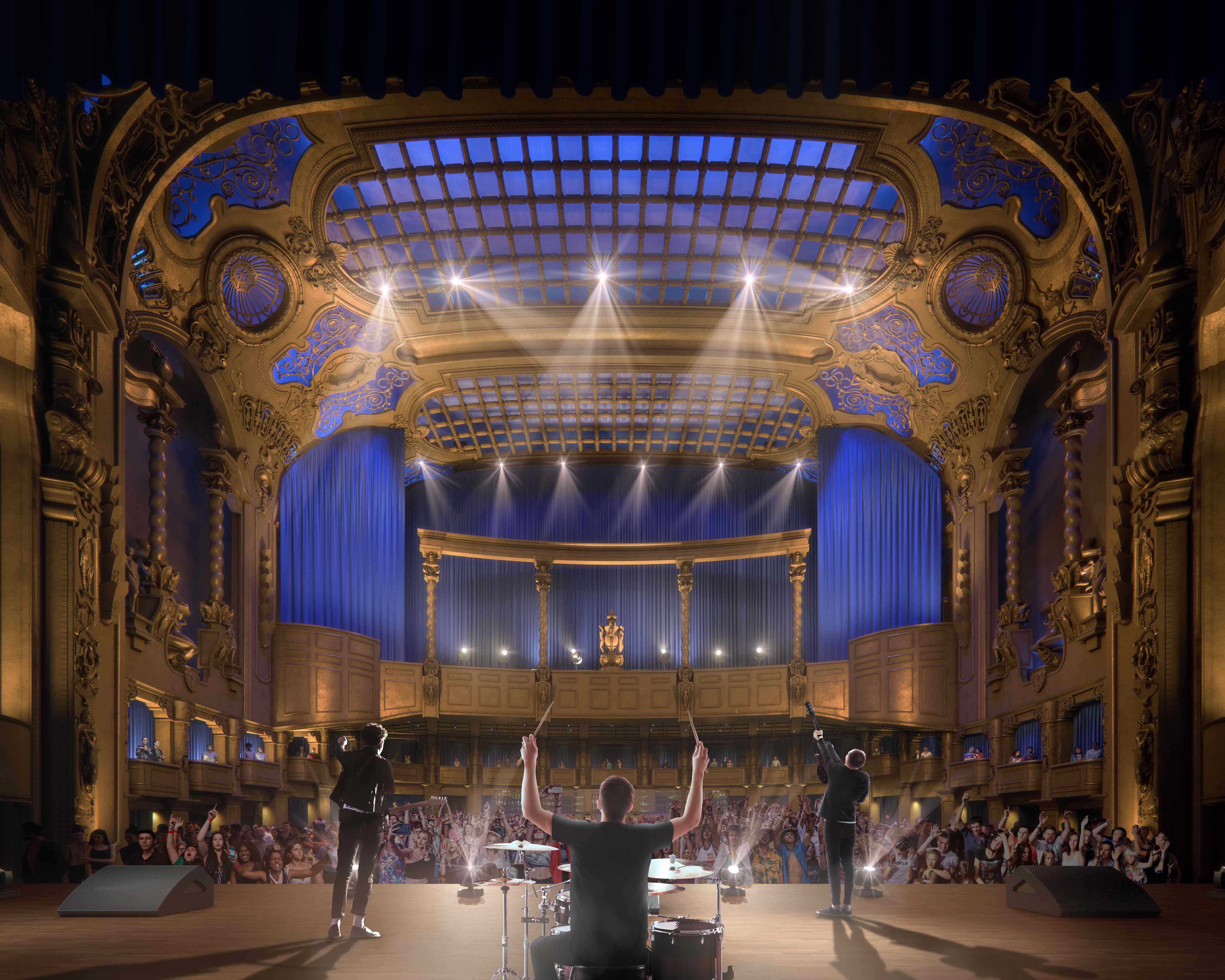The renovation of the iconic Brooklyn Paramount Theater restored the building to its original purpose as a movie theater and music performance venue. Long Island University had acquired the venue in the 1960s and repurposed it as the school’s basketball court.
The recently completed restoration preserved historical features while adapting to modern needs. Opened in 1928, the theater was renowned for hosting the world's first talking movies and showcasing legendary musical performers like Buddy Holly & The Crickets, Chuck Berry, Duke Ellington, and Ella Fitzgerald. Redesigned for owner Live Nation, it now accommodates contemporary artists while paying homage to its storied past.
Designed by Arcadis, the renovation incorporated a comprehensive marquee redesign, drawing inspiration from the original structure. The intricately designed ceiling was constructed with plaster, with special attention given to ensure its structural stability so that it is capable of withstanding intense bass vibrations of concerts. Collaborating with a lighting designer, the team illuminated the upper plaster dome, transforming it into a beautiful canvas enveloping the space in colored light to enhance the concert experience.
New life for Brooklyn Paramount Theater
By examining the venue’s original design and historical drawings from the 1920s, the design team salvaged intricate details and restored original architecture altered over the past century. The ticket lobby has been reimagined to align with modern aesthetics and security standards.
Upon entering the 2,700-capacity music hall, patrons are greeted by the featured bar before they encounter a sloped floor designed for optimal viewing. Old classrooms on the upper balcony were turned into mechanical areas to provide the space with modern comfort. The balcony’s original rococo columns with a colonnade, signaling the top of the venue, were replicated.
The second-level balcony boasts exclusive boxes and “Ella's VIP lounge,” paying homage to Fitzgerald's iconic performances in the 1950s. The intimate atmosphere of the VIP lounge showcases a small stage wrapped in a warm burnt-red drape. Over four dozen glistening gold disco balls add an additional level of sparkle to the space to set it apart from the rest of the venue.
Owner and/or developer: Live Nation / Long Island University
Design architect: Arcadis
Architect of record: Arcadis
MEP engineer: Highland Associates
Structural engineer: Thornton Tomasetti
General contractor/construction manager: Schimenti Construction Company



Related Stories
| Aug 11, 2010
Gold Award: Eisenhower Theater, Washington, D.C.
The Eisenhower Theater in the John F. Kennedy Center for the Performing Arts in Washington, D.C., opened in 1971. By the turn of the century, after three-plus decades of heavy use, the 1,142-seat box-within-a-box playhouse on the Potomac was starting to show its age. Poor lighting and tired, worn finishes created a gloomy atmosphere.
| Aug 11, 2010
Giants 300 University Report
University construction spending is 13% higher than a year ago—mostly for residence halls and infrastructure on public campuses—and is expected to slip less than 5% over the next two years. However, the value of starts dropped about 10% in recent months and will not return to the 2007–08 peak for about two years.
| Aug 11, 2010
Reaching For the Stars
The famed Griffith Observatory, located in the heart of the Hollywood hills, receives close to two million visitors every year and has appeared in such films as the classic “Rebel Without a Cause” and the not-so-classic “Charlie's Angels: Full Throttle.” Complete with a solar telescope and a 12-inch refracting telescope, multiple scientific exhibits, and one of the world...
| Aug 11, 2010
The Art of Reconstruction
The Old Patent Office Building in Washington, D.C., completed in 1867, houses two Smithsonian Institution museums—the National Portrait Gallery and the American Art Museum. Collections include portraits of all U.S. presidents, along with paintings, sculptures, prints, and drawings of numerous historic figures from American history, and the works of more than 7,000 American artists.
| Aug 11, 2010
Silver Award: Pere Marquette Depot Bay City, Mich.
For 38 years, the Pere Marquette Depot sat boarded up, broken down, and fire damaged. The Prairie-style building, with its distinctive orange iron-brick walls, was once the elegant Bay City, Mich., train station. The facility, which opened in 1904, served the Flint and Pere Marquette Railroad Company when the area was the epicenter of lumber processing for the shipbuilding and kit homebuilding ...
| Aug 11, 2010
Bowing to Tradition
As the home to Harvard's Hasty Pudding Theatricals—the oldest theatrical company in the nation—12 Holyoke Street had its share of opening nights. In April 2002, however, the Faculty of Arts and Sciences decided the 1888 Georgian Revival building no longer met the needs of the company and hired Boston-based architect Leers Weinzapfel Associates to design a more contemporary facility.
| Aug 11, 2010
Silver Award: Please Touch Museum at Memorial Hall Philadelphia, Pa.
Built in 1875 to serve as the art gallery for the Centennial International Exhibition in Fairmount Park, Memorial Hall stands as one of the great civic structures in Philadelphia. The neoclassical building, designed by Fairmount Park Commission engineer Hermann J. Schwarzmann, was one of the first buildings in America to be designed according to the principles of the Beaux Arts movement.
| Aug 11, 2010
Financial Wizardry Builds a Community
At 69 square miles, Vineland is New Jersey's largest city, at least in geographic area, and it has a rich history. It was established in 1861 as a planned community (well before there were such things) by the utopian Charles Landis. It was in Vineland that Dr. Thomas Welch found a way to preserve grape juice without fermenting it, creating a wine substitute for church use (the town was dry).
| Aug 11, 2010
Team Tames Impossible Site
Rensselaer Polytechnic Institute, the nation's oldest technology university, has long prided itself on its state-of-the-art design and engineering curriculum. Several years ago, to call attention to its equally estimable media and performing arts programs, RPI commissioned British architect Sir Nicholas Grimshaw to design the Curtis R.
| Aug 11, 2010
Silver Award: Hanna Theatre, Cleveland, Ohio
Between February 1921 and November 1922 five theaters opened along a short stretch of Euclid Avenue in downtown Cleveland, all of them presenting silent movies, legitimate theater, and vaudeville. During the Great Depression, several of the theaters in the unofficial “Playhouse Square” converted to movie theaters, but they all fell into a death spiral after World War II.







